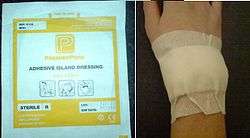Dressing (medical)

A dressing is a sterile pad or compress[1] applied to a wound to promote healing and protect the wound from further harm. A dressing is designed to be in direct contact with the wound, as distinguished from a bandage, which is most often used to hold a dressing in place. Many modern dressings are self-adhesive.
Medical uses
A dressing can have a number of purposes, depending on the type, severity and position of the wound, although all purposes are focused towards promoting recovery and protecting from further harm. Key purposes of a dressing are:
- Stem bleeding – to help to seal the wound to expedite the clotting process;
- Protection from infection – to defend the wound against germs and mechanical damage;
- Absorb exudate – to soak up blood, plasma, and other fluids exuded from the wound, containing it/them in one place and preventing maceration;
- Ease pain – either by a medicated analgesic effect, compression or simply preventing pain from further trauma;
- Debride the wound – to remove slough and foreign objects from the wound to expedite healing;
- Reduce psychological stress – to obscure a healing wound from the view of others.
Ultimately, the aim of a dressing is to promote healing of the wound by providing a sterile, breathable and moist environment that facilitates granulation and epithelialization. This will then reduce the risk of infection, help the wound heal more quickly, and reduce scarring.
Types

Historically, dressings were made of a piece of material, usually a cloth, but the use of cobwebs, dung, leaves and honey have also been described.
However, modern dressings[2] include dry or impregnated gauze, plastic films, gels, foams, hydrocolloids, alginates, hydrogels, and polysaccharide pastes, granules and beads. They all provide different physical environments suited to different wounds:
- Absorption of exudate, to regulate the moisture level surrounding the wound- for example, dry gauzes absorb exudate strongly, drying the wound, hydrocolloids maintain a moist environment and film dressings do not absorb exudate;
- Gas permeability and exchange, especially with regard to oxygen and water vapour;
- Maintaining the optimum temperature to encourage healing;
- Mechanically debriding a wound to remove slough.
Dressings can also regulate the chemical environment of a wound, usually with the aim of preventing infection by the impregnation of topical antiseptic chemicals. Commonly used antiseptics include povidone-iodine, boracic lint dressings or historically castor oil.[3] Antibiotics are also often used with dressings to prevent bacterial infection. Medical grade honey is another antiseptic option, and there is moderate evidence that honey dressings are more effective than common antiseptic and gauze for healing infected post-operative wounds.[4] Bioelectric dressings can be effective in attacking certain antibiotic-resistant bacteria[5] and speeding up the healing process.[6]
Dressings are also often impregnated with analgesics to reduce pain.
The physical features of a dressing can impact the efficacy of such topical medications. Occlusive dressings, made from substances impervious to moisture such as plastic or latex, can be used to increase their rate of absorption into the skin.
Dressings are usually secured with adhesive tape and/or a bandage. Many dressings today are produced as an "island" surrounded by an adhesive backing, ready for immediate application- these are known as island dressings.
Gauze dressings
Gauze dressings are the most commonly used dressing due to their simplicity and inexpensiveness, with a long history of use. Constructed from an open-weave fabric, usually cotton, traditional gauze dressings function as an absorbent, breathable and protective pad for a wound. Today, gauze dressings often have a layer of non-stick, perforated plastic film over the absorbent gauze to prevent excessive drying of a wound or adhesion to the dressing, but maintaining the gauze's ability to absorb exudate. Non-stick gauze island dressings are the most common type of dressing today- an example is the Band-Aid.
Biologics, skin substitutes, biomembranes and scaffolds
Advancements in understanding of wounds have commanded biomedical innovations in the treatment of acute, chronic, and other types of wounds. Many biologics, skin substitutes, biomembranes and scaffolds have been developed to facilitate wound healing through various mechanisms.[7]
Usage of dressings
Applying a dressing is a first aid skill, although many people undertake the practice with no training – especially on minor wounds. Modern dressings will almost all come in a prepackaged sterile wrapping, date coded to ensure sterility. Sterility is necessary to prevent infection from pathogens resident within the dressing.
Historically, and still the case in many less developed areas and in an emergency, dressings are often improvised as needed. This can consist of anything, including clothing or spare material, which will fulfill some of the basic tenets of a dressing – usually stemming bleeding and absorbing exudate.
Applying and changing dressings is one common task in nursing.
See also
References
- ↑ "First Aid Equipment, Supplies, Rescue, and Transportation". Hospital Corpsman. Naval Education and Training Command. 2003. pp. 3–1.
- ↑ "www.dressings.org". SMTL. Retrieved 2007-02-24.
- ↑ Gallant, A. E. (1897). "Report upon the Use of a Mixture of Castor oil and Balsam of Peru as a Surgical Dressing". Annals of Surgery. 26 (3): 329–339. PMC 1425429
 . PMID 17860484.
. PMID 17860484. - ↑ Jull AB, Cullum N, Dumville JC, Westby MJ, Deshpande S, Walker N (6 March 2015). "Honey as a topical treatment for wounds". Cochrane Database of Systematic Reviews. 3: CD005083. doi:10.1002/14651858.CD005083.pub4. PMID 25742878.
- ↑ Kim, H; Makin, I; Skiba, J; Ho, A; Housler, G; Stojadinovic, A; Izadjoo, M (24 Feb 2014). "Antibacterial efficacy testing of a bioelectric wound dressing against clinical wound pathogens". Open Microbiol J. 8 (1): 15–21. doi:10.2174/1874285801408010015. PMC 3950956
 . PMID 24627730.
. PMID 24627730. - ↑ Banerjee, Jaideep; Ghatak, Piya Das; Roy, Sashwati; Khanna, Savita; Sequin, Emily K.; Bellman, Karen; Dickinson, Bryan C.; Suri, Prerna; Subramaniam, Vish V.; Chang, Christopher J.; Sen, Chandan K. (3 March 2014). "Improvement of Human Keratinocyte Migration by a Redox Active Bioelectric Dressing". Plos One. 9 (3): e89239. Bibcode:2014PLoSO...989239B. doi:10.1371/journal.pone.0089239.
- ↑ Vyas KS, Vasconez HC. Wound Healing: Biologics, Skin Substitutes, Biomembranes and Scaffolds. Healthcare. 2014; 2(3):356-400. http://www.mdpi.com/2227-9032/2/3/356/htm